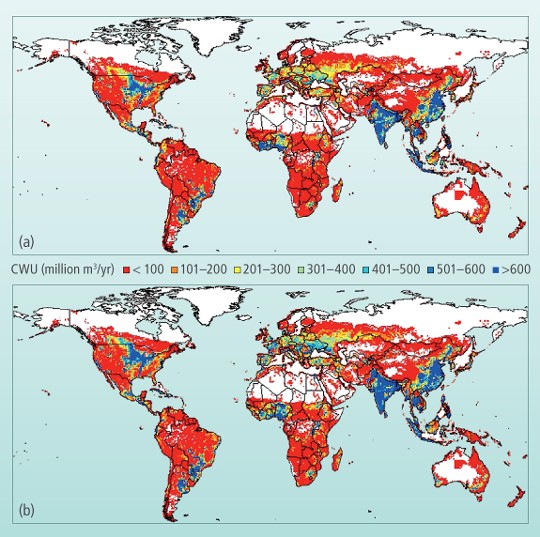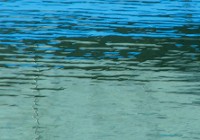Modeling
green and blue water
Global crop production uses four to five times more green than blue water, according to new research from Beijing Forestry University, the Swiss Federal Institute of Aquatic Science and Technology, and IIASA. Yet, as water managers have traditionally focused efforts on blue water management such as irrigation, improving green water management offers real potential for tackling the increasing water gap in food production (see bottom of page).
Currently around one-third of the world population suffers some form of water stress, and this is expected to increase to two-thirds over the next decades. Much of the water scarcity is the result of insufficient water for agricultural uses, in particular, food production. Globally, agricultural water use accounts for around 70 percent of blue water withdrawals and over 90 percent of total water use, when green water is also included.
Accurate assessment of global water uses at high spatial resolution, particularly agricultural water use, is a key to quantifying water scarcity. Yet detailed assessments of both green and blue water uses are rare. The study, published in the Journal of Hydrology, aims to help fill this gap with a detailed assessment of the quantities of blue and green water consumed in cropland across the globe (see maps). The research showed that crops consumed 5,938 km3 of water globally during growing periods in the year 2000, of which 84 percent was green water. Over the entire year, cropland used 7,323 km3 of water, 87 percent of which was green water.

World Water Use in the year 2000. The maps show the annual quantity of water consumed by cropland: (a) during crop growing periods and (b) during the entire year, to the nearest 30-arc minutes.
Over the coming decades growing populations will consume more blue water and demand more food, placing an ever-increasing pressure on agriculture to produce more food using less blue water. The research calculated that there is significant potential to increase food production by better water management in combination with nutrient management. “Many low-cost techniques for water management, including soil conservation tillage and rainwater harvesting techniques, have not been fully exploited in many regions,” says Professor Junguo Liu, lead author of the study. “Larger blue water projects like dams offer less potential because projects have already been developed in the most suitable locations. This leaves the improvement of green water management as an important option to guarantee world food security in the future.”
The study identifies the six countries with the highest consumption of water as China, the United States, India, Brazil, Russia, and Indonesia. Together, they consume over half (51.4 percent) of global water, mainly because of their enormous croplands which account for almost half (47 percent) of the world’s cropland. Parts of India, China, and the United States are the highest users of blue water, while arid or semi-arid regions, which use a higher proportion of blue water to make up for low rainfall, include north China, some west Asian countries, the Middle East and North Africa, the western United States, and Chile.
The researchers also examined the trade in virtual water in which water-scarce countries overcome water shortages by importing water-intensive food. The two largest virtual water importers on a per capita basis are the Netherlands and Belgium mainly because of the large amount of feed concentrates and raw materials (e.g., cassava and soybeans) they import for livestock, much of which is then exported as meat.
Green water is the soil water held in the unsaturated zone, formed by precipitation and available to plants, while blue water refers to liquid water in rivers, lakes, wetlands, and aquifers, which can be withdrawn for irrigation and other human uses. Irrigated agriculture receives blue water (from irrigation) as well as green water (from precipitation), while rainfed agriculture receives only green water. Rainwater harvesting is at the interface of blue and green water. Catching runoff and storing it in small reservoirs (or possibly underground) is interpreted as blue water management, while enhancement of soil infiltration is green water management.
Extract from: Hoff H, Falkenmark M, Gerten D, Gordon L, Karlberg L, Rockström (2010). Greening the Global Water System. Journal of Hydrology 384(3–4):177–186.
Read this issue of Options magazine


